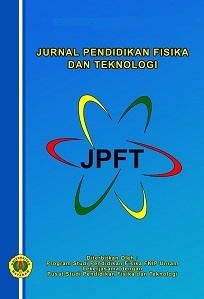Pengaruh Model Conceptual Understanding Procedures Terhadap Penguasaan Konsep dan Kemampuan Pemecahan Masalah Fisika Peserta Didik Kelas X SMAN 1 Gerung
DOI:
10.29303/jpft.v5i1.777Published:
2019-07-01Issue:
Vol. 5 No. 1 (2019): Januari - JuniKeywords:
Problem-solving abilities, conceptual understanding proceduresArticles
Downloads
How to Cite
Downloads
Metrics
Abstract
Quasi experimental research with "non-equivalent control group design" aims to determine the effect of conceptual understanding procedures model on the mastery of concepts and ability to solve the physics problems of class X students SMAN 1 Gerung tahun 2017/2018. Population in this research is all students of class X MIPA SMAN 1 Gerung with sampling technique using purposive sampling, so selected class X MIPA 2 as experiment class and class X MIPA 5 as control class. Data collection of the mastery of concepts was performed using multiple choice test with mean score for experimental class of 72,96 and for control class equal to 63,29 and problem solving ability using essay test with mean value for experiment class was 56,30 and for the control class of 44.48. After the teaching, the mastery of the concepts of both classes increased, the second highest grade values occurred in the mechanical energy sub-material with the percentage of 69% in the experimental class and 66% in the control class whereas the second lowest grade occurred on the restoring force sub-material. Problem-solving abilities (PSAs) were 6 indicators, in the control class PSA-1 higher than the experimental class, while the PSA-2 through the PSA-6 experimental class was higher than the control class. The hypothesis of this study was tested by the test-t polled variance with a significant level of 5% and obtained t count of 4.65 for the mastery of concepts and t count of 3.50 for problem-solving abilities while the t table value of 1.99 means t count more great from t table. The results of this study indicate that there is influence conceptual understanding procedures model to the mastery of the concept and ability of solving physics problems of students class X SMAN 1 Gerung academic year 2017/2018.References
Fitriani, N., Gunawan, G., dan Sutrio, S. 2017. Berfikir Kreatif dengan Model Pembelajaran Conceptual Understanding Procedures Berbantuan LKPD. Jurnal Pendidikan Fisika dan Teknologi. 1(3): 24-33.
Gummah, S., Soraya, L. H., Ahzan, S., dan Hardariyanti, H. (2014). Penerapan Model Pembelajaran Kooperatif Teknik Conceptual Understanding Procedures untuk Meningkatkan Hasil Belajar dan Aktivitas Siswa. Prisma Sains: Jurnal Pengkajian Ilmu dan Pembelajaran Matematika dan IPA IKIP Mataram. 2(2): 310-315.
Hidayati, F. dan Sinulingga, K. (2015). Pengaruh Model Pembelajaran Conceptual Understanding Procedures (Cups) terhadap Hasil Belajar Siswa pada Materi Pokok Listrik Dinamis Di Kelas X Semester II SMA Negeri 1 Binjai TP 2014/2015. INPAFI (Inovasi Pembelajaran Fisika). 3(4): 59-66.
Ibrahim, I., Kosim, K., dan Gunawan, G. 2017. Pengaruh Model Pembelajaran Conceptual Understanding Procedures Berbantuan LKPD terhadap Kemampuan Pemecahan Masalah Fisika. Jurnal Pendidikan Fisika dan Teknologi. 1(3): 14-23.
Ismawati, I., Nugroho, P., dan Dwijananti, D.2014. Penerapan Model Pembelajaran Conceptual Understanding Procedures untuk Meningkatkan Curiosty dan Pemahaman Konsep Siswa. Jurnal Pendidikan Fisika Indonesia. 10: 22-27.
Prastiwi, I., Soedjoko, E., dan Mulyono. 2014. Efektivitas Pembelajaran Conceptual Understanding Procedures untuk Meningkatkan Kemampuan Siswa pada Aspek Koneksi Matematika. Jurnal Kreano. 1(5): 41-47.
Sahidu, C. 2013. Penilaian Hasil Belajar. Mataram: Arga puji Press.
Setyosari, P. 2015. Metode Penelitian Pendidikan dan Pengembangan. Jakarta: Prenada Media Group.
Sugiyono. 2012. Statistika untuk Pendidikan. Bandung: Alfabeta.
Sundayanan, R. 2015. Statistika Penelitian Pendidikan. Bandung: Alvabeta.
Wena, M. 2014. Strategi Pembelajaran Inovatif Kontemporer. Jakarta Timur: PT Bumi Aksara.
Wulandari, M. L, Sutrio, S., dan Rahayu, S. 2017. Pengaruh Model Pembelajaran Conceptual Understanding Procedures terhadap Hasil Belajar Fisika Siswa Kelas XI SMA Negeri 5 Mataram Tahun Ajaran 2015/2016. Jurnal Pendidikan Fisika dan Teknologi. 2(3): 188-196.
Author Biographies
Nurul Hidayah, Universitas Mataram
Hikmawati Hikmawati, Universitas Mataram
Sutrio Sutrio, Universitas Mataram
License
Authors who publish with Jurnal Pendidikan Fisika dan Teknologi (JPFT) agree to the following terms:
- Authors retain copyright and grant the journal right of first publication with the work simultaneously licensed under a Creative Commons Attribution License 4.0 International License (CC-BY-SA License). This license allows authors to use all articles, data sets, graphics, and appendices in data mining applications, search engines, web sites, blogs, and other platforms by providing an appropriate reference. The journal allows the author(s) to hold the copyright without restrictions and will retain publishing rights without restrictions.
- Authors are able to enter into separate, additional contractual arrangements for the non-exclusive distribution of the journal's published version of the work (e.g., post it to an institutional repository or publish it in a book), with an acknowledgement of its initial publication in Jurnal Pendidikan Fisika dan Teknologi (JPFT).
- Authors are permitted and encouraged to post their work online (e.g., in institutional repositories or on their website) prior to and during the submission process, as it can lead to productive exchanges, as well as earlier and greater citation of published work (See The Effect of Open Access).











